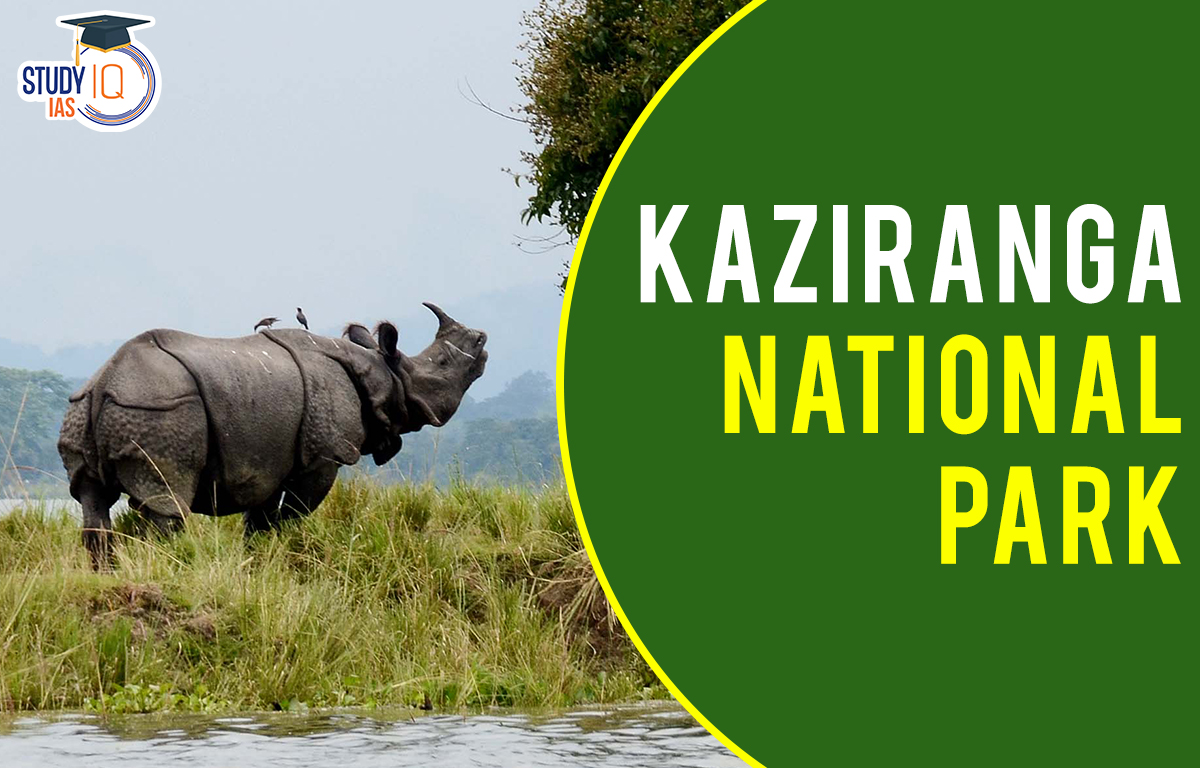Table of Contents
Context: Prime Minister Modi takes ‘elephant and jeep safari’ at Kaziranga National Park in Assam.
Kaziranga National Park
Kaziranga National Park is a national park in the Golaghat and Nagaon districts of the state of Assam, India. It is one of the most important wildlife sanctuaries in the world and is particularly famous for its population of one-horned rhinoceros. Two-thirds of the world’s one-horned rhinoceroses live in Kaziranga. National parks and animal refuges play an essential role in the UPSC Syllabus‘ Environment & Ecology and Biodiversity sections.
Kaziranga National Park History
The Indian rhinoceros and their habitat were the primary targets of protection when Kaziranga National Park was first created as a “Reserve Forest” in 1905. Kaziranga National Park was established as a Game Reserve in 1916, and it later changed its status to a Wildlife Sanctuary in 1950. Kaziranga National Park was established as a national park on January 1, 1974. It received the UNESCO World Heritage Site designation in 1985. Following a decline in the tiger population, the Indian government authorized the creation of the Kaziranga Tiger Reserve in August 2006.
Kaziranga National Park Features
One of India’s earliest reserves is known as Kaziranga National Park. It can be found in the Indian state of Assam’s regions of Nagaon, Sonitpur, and Golaghat. Because Kaziranga is situated in the Brahmaputra Rover floodplain, the earth there is abundant in alluvial deposits. Small rivers run through the park from east to west and drain into the Brahmaputra River.
The biggest secured area on the southern bank of the Brahmaputra River, Kaziranga National Park has a land area of 1030 km2. Kaziranga National Park is currently overseen by the Assam State Government’s environment department.
Kaziranga National Park Important Species
One-horned rhinoceros are among Kaziranga National Park’s top draws. Aside from that, the major attractions of this national park are the elephant Asiatic water buffalo and the royal Bengal tier. According to the 2018 census, Kaziranga National Park is home to 2,413 rhinoceros in total and roughly 1,100 elephants. Nine out of the 14 types of primates on the Indian subcontinent are found in Kaziranga National Park.
The number of one-horned rhinos in Pobitora Wildlife Sanctuary is the highest in the entire globe. The second-highest concentration of rhinos in Assam is found in Kaziranga National Park. There are about 35 different mammal species in Kaziranga National Park, and 15 of them are classified in Schedule I of the Wildlife Protection Act of 1972. With 103 tigers, Kaziranga National Park ranks third in India behind Jim Corbett and Bandipur National Park.
Wetland Bird Census 2019
96 different kinds of wetland birds have been found in Kaziranga National Park. It ranks among the greatest totals for Indian wildlife reserves. Over time, the survey has noted a change in the types and numbers of birds. The northern pintail variety and the bar-headed goose both have significant shares. The park’s Bagori, Kohora, and Burapahar have all been surveyed. The Eurasian wigeon, gadwall, little cormorant, northern lapwing, spot-billed pelican, and ruddy shelduck are additional species found in this area.
Kaziranga National Park Floral Diversity
You can find Indian gooseberries, cotton trees, tall eggplant grass, dese broadleaf woods, alluvial savanna woodlands, and marshlands here. There are countless smaller bodies of water in Kaziranga as well. Because of the frequent flooding, wetland areas, deciduous woods, and grasslands can also be seen.
Kaziranga National Park and One-Horned Rhinoceros
The IUCN Red List categorizes the one-horned rhinoceros as Vulnerable. The preservation of these rhinos is now a top concern. Kaziranga National Park is an important refuge because it is home to half of the world’s rhinos. A solitary black horn that is 9 to 25 inches long and a grey-brown hide with folds in the skin help identify one-horned rhinos. These one-horned rhinos feed on grasses, tree limbs, fruit leaves, and aquatic plants.
Kaziranga National Park and Flood Impact
Floods play an important part in the maintenance of the tiger reserve’s ecological system. The yearly feature of Kaziranga National Park is floods. Flooding promotes soil formation and silt deposition while also assisting in the upkeep of flora. The floods’ ability to regenerate aids in maintaining the environment and reviving Kaziranga’s water bodies. Fish also use floodwater as a breeding site. However, the annual flooding of the Brahmaputra River poses a significant challenge for the Kaziranga National Park.
Kaziranga National Park Significance
Two-thirds of the world’s giant one-horned rhinoceroses reside there (IUCN Status- Vulnerable). The name Karbi, a woman who governed here in antiquity, is adopted as the title Kaziranga. Alluvial deposits from the Brahmaputra and its tributaries created Kaziranga’s entire territory.
Also Read: Jim Corbett National Park
Kaziranga National Park Threats
Due to the numerous water bodies in Kaziranga National Park, it floods annually when it rains nonstop. Because the powerful Brahmaputra passes through these regions, the eastern and northern portions of the park are the most impacted. One of the main problems during the summer rains is soil erosion.
Another significant issue and danger to the Kaziranga National Park is the killing of rhinos by poachers. Another worrying issue is the expanding human populace near the park. The rapid urbanization of rhino habitats is problematic because it can result in several harmful activities, such as market contraction and farming expansion.
Kaziranga National Park UPSC
Since Kaziranga National Park is a hot subject right now, questions about it are consistently included in the UPSC Exam. This text provides enough details about Kaziranga National Park to be helpful during the planning stage. Candidates can go to the official website of StudyIQ UPSC online coaching to learn more about the UPSC Examination. Students can go for the UPSC Mock Test to enhance their preparations for their upcoming examinations.


 List of Awards and Honours Received by N...
List of Awards and Honours Received by N...
 List of GI Tag Products in India 2025, S...
List of GI Tag Products in India 2025, S...
 Hurun Global Unicorn Index 2025: Key Hig...
Hurun Global Unicorn Index 2025: Key Hig...





















